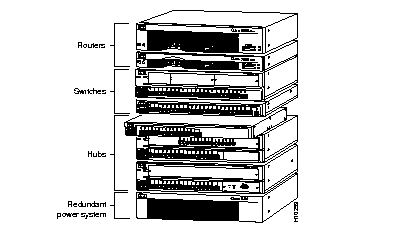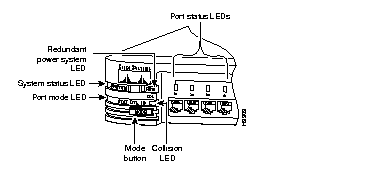|
|

The FastHub 116T is an unmanaged 16-port 100BaseT Class II repeater for workgroups and server farms. It is a member of an extended network system of stackable, modular LAN and WAN products that increase LAN performance, connect remote offices and users, and provide secure access. Figure 1-1 shows the network system units.

The FastHub has 16 fixed 100BaseTX ports (with an alternative uplink port for connecting to other 100BaseTX hubs). Table 1-1 summarizes the FastHub features.
| Feature | Description |
|---|---|
| Compatibility |
|
|
Performance | 100-Mbps peak and aggregate throughput. |
| Redundancy | Supports connection to the optional Cisco redundant power system (RPS). |
The front panel of the FastHub provides 16 100BaseTX ports, a 100BaseTX uplink port, a set of LEDs, and a Mode button.
The ports on the front panel of the FastHub are all 100BaseTX ports with fixed RJ-45 connectors (see Figure 1-2). All ports are compatible with the 100BaseTX IEEE-802.3u specification and can connect to any 100BaseTX device through standard Category 5 unshielded twisted-pair (UTP) cable.

Ports 1x through 16x have their transmit (TD) and receive (RD) pairs internally crossed. Standard Category 5 UTP crossover cable is required when connecting these ports to another hub, switch, or router (unless you are connecting to the uplink port on another FastHub or 100BaseT hub).
Port 16, which is to the right of port 16x, is the 100BaseTX uplink port. This uplink port is not internally crossed. Standard Category 5 UTP straight-through cable is required when connecting this port to another FastHub 100BaseTX port or to the 100BaseTX port on another hub, switch, or router.
 | Caution You will disable both ports if you connect to both the uplink port (port 16) and port 16x. |
For more information on connecting to these ports, see the "Connecting from the 100BaseTX Ports on the FastHub" section in the "Installing the FastHub" chapter.
You can use the FastHub LEDs to monitor network activity and performance. Figure 1-3 shows the location of the LEDs and the Mode button.

The redundant power system LED shows the status of the RPS (see Table 1-2).
| Color | RPS Status |
|---|---|
| Off | Power OK (no RPS or RPS not powered up). |
| Solid green | Power OK (RPS powered up and OK). |
| Solid amber | Internal power supply not powered up, RPS connected but not OK. |
| Flashing green | RPS and FastHub internal power supply are both powered up. Only one power source can be supplying power to the FastHub. If you are using the RPS, the FastHub power cord must not be plugged in. If you are using the internal power supply, the RPS can be connected but must be powered down. |
The system status LED shows whether the FastHub is powered up and provides an indication of any problem with the main system board of the FastHub (see Table 1-3).
| Color | System Status |
|---|---|
| Off | FastHub powered down. |
| Solid green | FastHub powered up and operational; no power problems. |
| Solid amber | FastHub powered up but not operational; problem related to the main system board of the FastHub (not internal power supply or RPS). |
The group collision LED shows the frequency of collisions for all ports on the FastHub
(see Table 1-4). The LED flashes amber if one or more ports on the FastHub are involved in a collision.
| Color | System Status |
|---|---|
| Off | No collisions |
| Flashing amber | Collision |
| Solid amber | High number of collisions |
The port mode LED indicates the STAT (port status), UTL (bandwidth utilization), and ID (unit identification) modes.
In port status mode, port LEDs show individual port status (see Table 1-5).
| Color | Port Status |
|---|---|
| Off | No link (link down). |
| Green | Link operational (with no activity). |
| Flashing green | Link operational (with activity). |
| Rapidly alternating green/amber | Faulty link1. |
| Alternating green/amber | FastHub reset in progress. |
In utilization mode, bandwidth usage is shown for the FastHub. The port LEDs show the current bandwidth and the peak bandwidth usage that occurred since the last reset.
The far-right solid green LED denotes the peak bandwidth that was recorded since the last reset. All LEDs to the left of the solid green LED operate in a scalable pattern, flashing green from left to right, to show the current bandwidth utilization. Table 1-6 lists the port LEDs and the bandwidth associated with each LED.
| LED | Mbps Activity |
|---|---|
| Port 1 | 0 to 6.25 |
| Port 2 | 12.5 |
| Port 3 | 18.75 |
| Port 4 | 25 |
| Port 5 | 31.25 |
| Port 6 | 37.5 |
| Port 7 | 43.75 |
| Port 8 | 50 |
| Port 9 | 56.25 |
| Port 10 | 62.50 |
| Port 11 | 58.75 |
| Port 12 | 75 |
| Port 13 | 81.25 |
| Port 14 | 87.5 |
| Port 15 | 93.75 |
| Port 16 | 100 |
In unit identification mode, the LED for port 1 is solid green, indicating that the unit ID number for the FastHub is 1. For the FastHub 116T, the unit ID number is always 1.
To change the mode being displayed by a port LED, press the Mode button to highlight in sequence each of the modes: STAT, UTL, and ID. The Mode button is independent of the Collision LED. When the desired mode is selected, release the button to make the change. As long as you hold the Mode button down, the mode does not change. The selected mode remains on for 30 seconds before returning to the default mode of STAT (port status).
The rear panel of the FastHub provides an AC power receptacle and a redundant DC power system (RPS) receptacle (see Figure 1-4). Only one power source can be supplying power to the FastHub. Disconnecting power to the FastHub resets the FastHub itself.
If you want to use the internal power supply, which is an autoranging unit supporting input voltages of 90 to 127/200 to 250 VAC, use the supplied AC power cord to connect the AC power receptacle to an AC power outlet.
If you are using the RPS, the supplied AC power cord must not be plugged in. See the Cisco RPS documentation for detailed information on connecting to the RPS.
 | Warning Use the Cisco RPS (model NFS0600-9632PE) only to power the external device. |

This section describes several possible network configurations using the FastHub.
You can create 100-Mbps workgroups by interconnecting FastHubs (FastHub 116T, FastHub 216T, and FastHub 300 series), as shown in Figure 1-5.

Using the FastHub, you can create 100-Mbps server farms to increase centralized and decentralized server performance, as shown in Figure 1-6.

A system of routers, switches, and hubs can be combined to create a high-performance network that extends beyond the main office LAN to connect to branch offices, remote sites, mobile users, and the Internet. Figure 1-7 is an application for an extended network system.

|
|